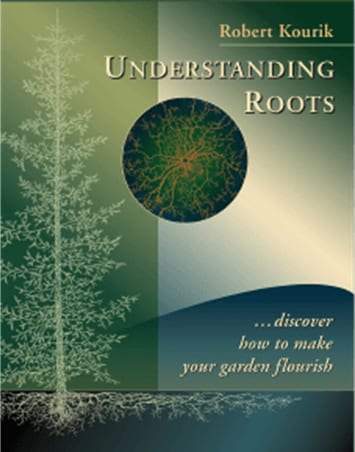 Written by Robert Kourik
Written by Robert Kourik
Published by Metamorphic Press, August 2015
Reviewed by: M.L. Altobelli
The books of Robert Kourik should be in every land manager’s library. Understanding Roots is his newest book and adds to and updates information found in Designing and Maintaining Your Edible Landscape Naturally (2005) and Roots Demystified (2007). Like many of the best in the ecological landscape field (to include design, installation and management), he’s a maverick, in the best sense; and he has gathered together a fantastic and detailed look at what it takes for plants truly to succeed in the landscape. I use all of his books as essential props in gardening classes.
Roots are the key to any plant, not just the top that we see (and buy – or our clients buy), and Kourik’s books provide the essential graphics that help all of us (or at least me!) visualize what happens underground. I’ve always been personally fascinated by roots ever since I discovered root tips and root hairs way back in time. Fascination met with practicality when I had a client who bought whatever plant caught her attention, whether it had a healthy root system or not. She left these plants on the driveway for me to find homes for them in her gardens – with the expectation that everything would survive of course! This one client offered a crash course in what works and when I discovered Kourik’s book, I had access to a lot of the missing links in the rooting chain – excavating a pepper to see if it matched what was diagramed was illuminating! Some parts matched and some didn’t but I’ve handled soils and roots better ever since.
Understanding Roots directly targets the green industry. Kourik has brought some of the most interesting work on woody roots together in one book. Most of you have probably seen at least some of Dr. John Weaver’s line drawings of common garden plants like lettuce and tomatoes, but this new book uses drawings from Germany and Hungary that detail how all kinds of woody roots – like maples and fruit trees – look underground. What you see might surprise you and provide some much needed clarity on mulches – their effects and application rates. All of us need a better understanding of what covers a woody root system (and then we need to sell it to our clients).
Kourik emphasizes that roots are fascinating. Here’s a quote from the Deep Roots and Nutrients chapter that captures the essence of the entire book: “It’s simple, focus on the care of the upper 8-12 inches of the root zone…. Tend to the aerobic microbiology in the very upper zones of the soil. Keep it ever so slightly moist and “well fed” with compost, organic fertilizers and mulch…. Avoid turning, churning and displacing soil layers. In short: treat your soil with a dynamic accumulation of kindness.” (p95) Much of the book outlines the research that backs up these statements.
For land managers, probably the most useful sections in the book are the ones that detail working with nursery stock in the “Transplanting Roots,” “Mulching Tree Roots,” and “A Favorable Fungus” chapters. These are directed specifically to what we do – get woody plants to establish creditably into a built environment. Turns out that slicing all of the outside roots off of a containerized tree or shrub might be the best way to go after all.
So take the time to look into this book and refresh your ideas about what woody roots do and how they behave. Check out the support patterns of mulch, compost, and fertilizers around tree roots. Determine where the actual feeding roots are before you go out and work on your client’s land – large plot or small. The results will be worth the effort.
About the Reviewer
M.L. Altobelli has been creating and maintaining fine gardens for over 25 years and brings a strong commitment to creating sustainable soils for healthy people, flower, trees, and grass to all of her sites. With a B.S. in Animal Science, M.L. has read widely about plants and soil, and she experiments to find ecological and organic solutions that suit the individual site. She was a founding member of ELA. She currently works at Woody End Farm and Greenery in Motion and is involved with her local agricultural commission.
Each author appearing herein retains original copyright. Right to reproduce or disseminate all material herein, including to Columbia University Library’s CAUSEWAY Project, is otherwise reserved by ELA. Please contact ELA for permission to reprint.
Mention of products is not intended to constitute endorsement. Opinions expressed in this newsletter article do not necessarily represent those of ELA’s directors, staff, or members.

